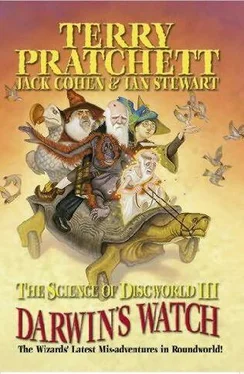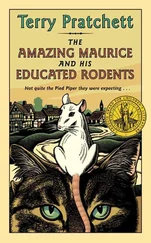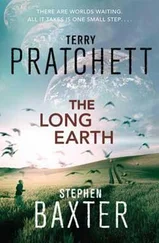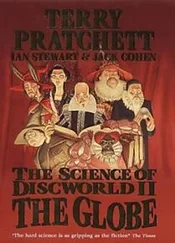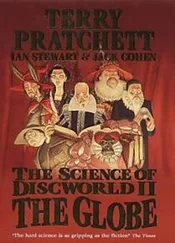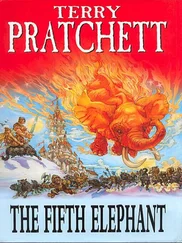Terry Pratchett - The Science of Discworld III - Darwin's Watch
Здесь есть возможность читать онлайн «Terry Pratchett - The Science of Discworld III - Darwin's Watch» весь текст электронной книги совершенно бесплатно (целиком полную версию без сокращений). В некоторых случаях можно слушать аудио, скачать через торрент в формате fb2 и присутствует краткое содержание. Жанр: Фантастика и фэнтези, на английском языке. Описание произведения, (предисловие) а так же отзывы посетителей доступны на портале библиотеки ЛибКат.
- Название:The Science of Discworld III - Darwin's Watch
- Автор:
- Жанр:
- Год:неизвестен
- ISBN:нет данных
- Рейтинг книги:3 / 5. Голосов: 1
-
Избранное:Добавить в избранное
- Отзывы:
-
Ваша оценка:
- 60
- 1
- 2
- 3
- 4
- 5
The Science of Discworld III - Darwin's Watch: краткое содержание, описание и аннотация
Предлагаем к чтению аннотацию, описание, краткое содержание или предисловие (зависит от того, что написал сам автор книги «The Science of Discworld III - Darwin's Watch»). Если вы не нашли необходимую информацию о книге — напишите в комментариях, мы постараемся отыскать её.
The Science of Discworld III - Darwin's Watch — читать онлайн бесплатно полную книгу (весь текст) целиком
Ниже представлен текст книги, разбитый по страницам. Система сохранения места последней прочитанной страницы, позволяет с удобством читать онлайн бесплатно книгу «The Science of Discworld III - Darwin's Watch», без необходимости каждый раз заново искать на чём Вы остановились. Поставьте закладку, и сможете в любой момент перейти на страницу, на которой закончили чтение.
Интервал:
Закладка:
Lyell realised that the age of the Earth must be many millions of years, when he looked at sedimentary rocks. These are rocks like limestone or sandstone which form in layers, and have been deposited either underwater, as muddy sediments, or in deserts, as accumulating sand. (Independent evidence for these processes comes from the fossils found in such rocks.) By studying the rate at which modern sediments accumulate, and comparing that with the thickness of known beds of sedimentary rock, Lyell could estimate the time it had taken for the layers of rock to be deposited. Something in the range 1000-10,000 years would produce a layer about a metre thick. But the chalk cliffs of the south coast, around Dover, are hundreds of metres thick. So that's several hundred thousand years of deposition, and we've only dealt with one of the numerous layers of rock that make up the geological column - the historical sequence of different rocks.
We now have many other kinds of evidence for the great age of our planet. The rate of decay of radioactive elements, which we can measure today and extrapolate backwards, is in general agreement with the evidence of the rock layers. The rate of movement of the continents, when combined with the distances they have moved, is again consistent with other estimates. We've seen that India was once attached to Africa, but about 200 million years ago it broke off, and by 40 million years ago it had moved all the way to its current position, butting up against Asia and pushing up the Himalayas.
When continents move apart - as Africa and South America, or Europe and North America, are doing now - new material forms on the ocean floor, flowing out from the mantle beneath to form huge mid-ocean ridges. The rocks in the ridges contain a record of the changes in the Earth's magnetic field, `frozen in' as the rock cooled. They show a long series of repeated reversals of the field polarity. Sometimes the `north' magnetic pole is at the northern end of the Earth, as now, but every so often the polarity flips, so that the magnetic pole near the northern end is the `south' one. Mathematical models of the Earth's magnetic field predict that such reversals occur roughly once every five million years. Count the number of reversals in the ocean-ridge rocks, multiply by five million ... again, the numbers fit reasonably well, and careful comparisons and a lot of disputation by experts lead to revised numbers that fit even better.
The Grand Canyon is a deep gash through layers of rock one mile (1.6km) thick. You have a choice. You can understand what the record of the rocks is telling you here: it took a very long time to lay down those rocks, and quite a long time - though less - for flashflooding in the Colorado river to erode them again. Or you can follow one book that until recently was displayed in the `science' section of the Grand Canyon bookstore, until a lot of scientists complained, and assert that the Grand Canyon is evidence for Noah's flood. The first choice fits huge amounts of evidence and geological understanding. The second is an excellent test of faith, because it fits absolutely nothing. A flood that lasted only 40 days could never have produced that kind of geological formation. A miracle? In that case, the Sahara desert could equally well be hailed as evidence for Noah's flood, miraculously not forming a deep canyon. Once you admit miracles, you can't pursue a logical thread.
Anyway, that's the second ingredient - Deep Time. It takes huge amounts of time to change organisms into entirely new species, if all you can do - as Darwin believed - is make very gradual changes. But even Deep Time, when combined with heritable variation, is not enough to lead to the kind of organised, coherent changes that are needed to create new species. There has to be a reason for such changes to occur, as well as opportunity and time. Darwin, as we've seen, found his reason in Malthus's contention that the unchecked growth of organisms is exponential, whereas that of resources is linear. In the long run, exponential growth always wins.
The first assertion is pretty much correct, the second highly debatable. The qualifier `unchecked' is crucial, and real populations only grow exponentially if there are plenty of resources available. Typically, the growth starts exponentially with a small population and then levels off as the population size increases. But in most species, two parents (let's think sexual species here) produce some larger number of offspring. A breeding female starling lays about 16 eggs in her life, and with `unchecked' growth, the starling population would multiply by 8 every lifetime. It would not be long before the planet was knee-deep in starlings. So, of necessity, 14 of those 16 offspring (on average) fail to breed - usually because something eats them. Just two become parents in their turn. A female frog may lay 10,000 eggs in her life, and nearly all die in various grotesque ways to achieve each two parents; a female cod contributes forty million or thereabouts of her offspring to planktonic food chains, for each two that breed. Here the multiplier, with `unchecked' growth, would be 20 million per cod-lifetime. Unchecked growth simply doesn't bear thinking about as a realistic prospect.
We suspect that Malthus plumped for linear growth of resources for a slightly silly reason. Victorian school-textbook mathematics distinguished two main types of sequence: geometric (exponential) and arithmetic (linear). There were plenty of other possibilities, but they didn't get into the textbooks. Having already assigned geometric growth to organisms, Malthus was left with arithmetic growth for resources. His main point doesn't depend on the actual growth rate, in any case, as long as it is less than exponential. As the starling example shows, most offspring die before breeding, and that's the main point here.
Given that most young starlings cannot possibly become parents, the question arises: which ones will? Darwin felt that the ones that survived to breed would be the ones best suited for survival, which makes sense. If one starling is better at finding food, or hanging on to it, than another one, then it's clear which one is more likely to do best if food supplies become limited. The better one might be unlucky and get eaten by a hawk; but across the population, starlings that are better equipped to survive are generally the ones that do survive.
This process of `natural selection' in effect plays the role of an external breeder. It chooses certain organisms and eliminates the rest. The choice is not conscious - there is no consciousness to do the choosing, and no preconceived purpose - but the end result is very similar. The main difference is that natural selection makes sensible choices, whereas human selection can make ridiculous ones (like dogs with faces so flattened they can hardly breathe). Sensible choices lead to sensible animals and plants, ones that are beautifully adapted for survival in whatever environment they happened to be in when natural selection was moulding them.
It is just like breeding new varieties of pigeon, but without a human breeder. Natural selection exploits the same variability of organisms that pigeon-breeding does. It makes choices based on survival value (in some environment) rather than whim. It is typically much slower than human intervention, but the timescale is so vast that this slowness doesn't matter much. Heritable variation plus natural selection inevitably lead, over Deep Time, to the origination of species.
Nature does it all on her own. There is no need for a series of acts of special creation. That doesn't imply that special creation has not occurred. It just removes any logical imperative for it.
Paley was wrong.
The watches don't need a watchmaker.
They can make themselves.
13. INFINITY IS A BIT TRICKY
Интервал:
Закладка:
Похожие книги на «The Science of Discworld III - Darwin's Watch»
Представляем Вашему вниманию похожие книги на «The Science of Discworld III - Darwin's Watch» списком для выбора. Мы отобрали схожую по названию и смыслу литературу в надежде предоставить читателям больше вариантов отыскать новые, интересные, ещё непрочитанные произведения.
Обсуждение, отзывы о книге «The Science of Discworld III - Darwin's Watch» и просто собственные мнения читателей. Оставьте ваши комментарии, напишите, что Вы думаете о произведении, его смысле или главных героях. Укажите что конкретно понравилось, а что нет, и почему Вы так считаете.
